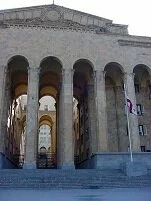
Parliament in Tbilisi
Other than churches, some of the only still-standing structures from the medieval time period are the houses in Chazhashi, which were built in the 1100s. These are the earlier example of domestic architecture in the country and their stone remains continue to stand today.
From the 1100s until the 1800s most of the still-standing architecture are the churches that represent a very similar style to both Jvari Monastery and the other churches in Mtskheta. In the 1800s the Russians took over the region and the style began to change. Much of the Russian architectural style was introduced in Georgia, particularly in civil buildings and this is most noticeable in larger cities like Tbilisi. This time also experienced an influx of neo-Classicism.
Since the 1800s homes have combined a number of design features, primarily from Russia, but also with a strong historical emphasis as the facades remain unique and balconies or porches are ever-present.

Modern bridge in Tbilisi
When the Soviet took over Russia, Georgia soon fell under their rule and the architecture changed to match the Soviet ideals of strength and efficiency, leading to larger buildings with little attention paid to aesthetics. Again, this is best displayed in the larger cities, primarily on the outskirts of these cities.
Today, Georgia is again trying to reclaim their historic architecture and most modern architecture in the country is a combination of modern materials and techniques coupled with cultural aspects of houses and churches, creating a new style, not entirely different from their past.